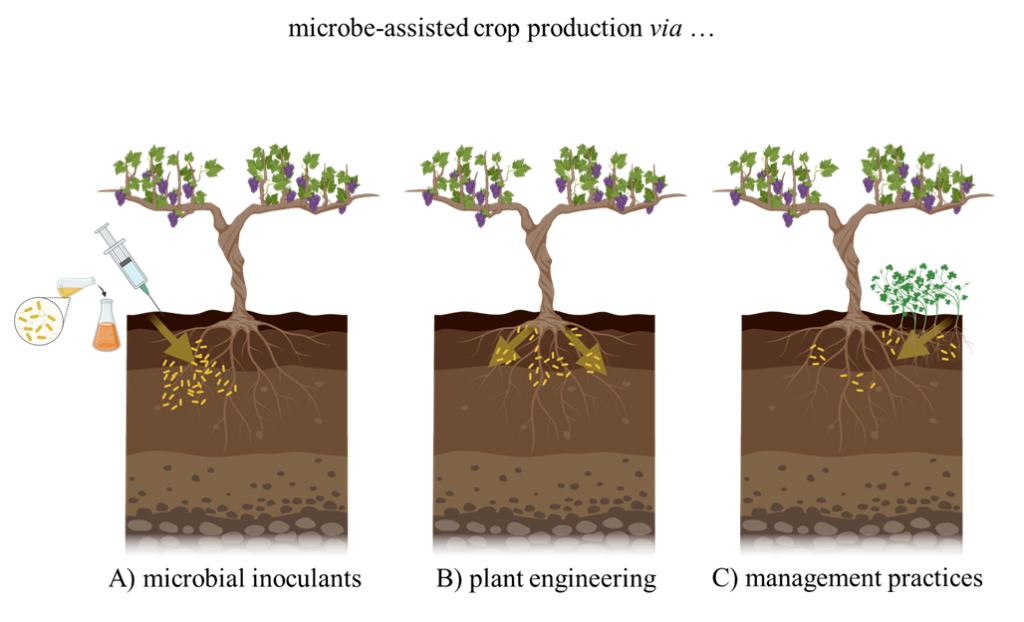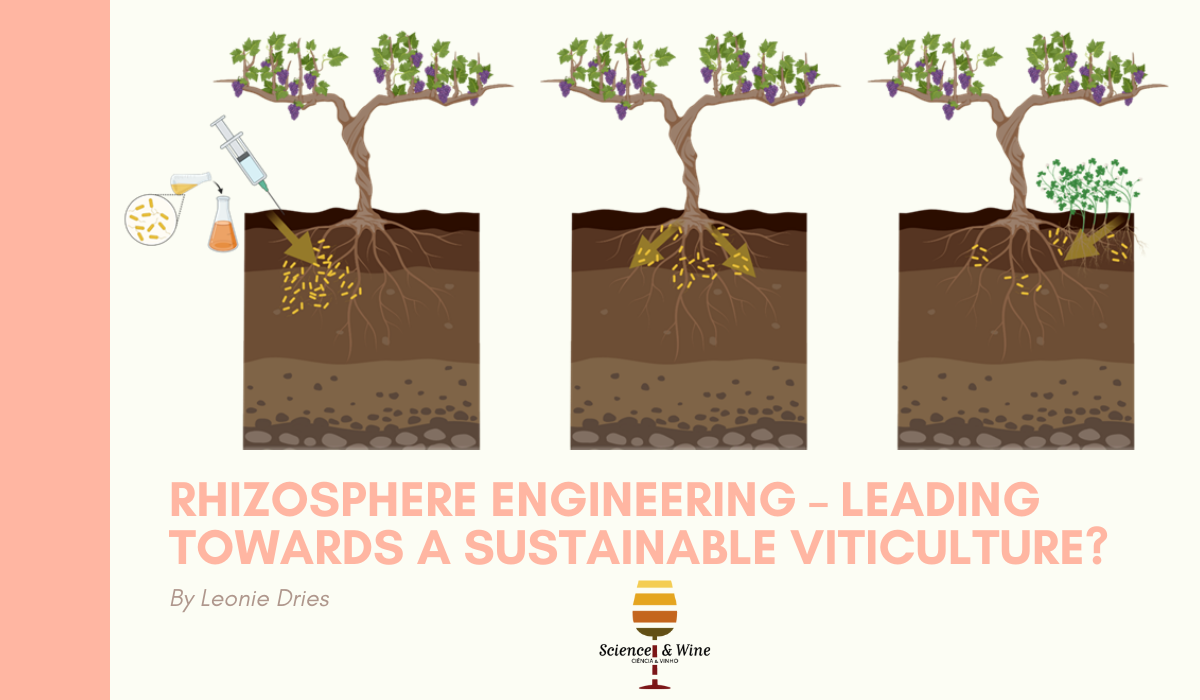By Leonie Dries
Soil quality and soil health are important factors for sustainable farming [1]. Sustainability is a frequently used term [2], especially nowadays of increasing awareness of ongoing climate change, loss of biodiversity, and environmental pollution. Due to this increased awareness, and also in response to rising restrictions on synthetic pesticide usage, there has been a movement toward the adoption of more sustainable agricultural and viticultural practices [3–5]. The productivity of agricultural systems is greatly dependent on the functional processes of soil microorganisms, especially within the rhizosphere [6]. The quest for higher yields leads to an intensification in crop production, which results in a loss of soil fertility and quality [7].
Soil inhabits various biotic and abiotic processes, which are linked to key ecosystem functions like the cycling of carbon and other nutrients [8]. In terms of plant nutrition, plant health and crop quality, the most important is the soil that directly surrounds the plant’s root space – the rhizosphere [9]. The rhizosphere differs from bulk soil and is defined as the area of the soil that is physically, chemically and biologically influenced by the living root of the plant [10]. In particular, the microbiome of the rhizosphere can positively influence plant development, vitality and growth by providing and acquiring nutrients and has frequently been targeted to identify positive plant–microbial relationships [11]. It is known that certain beneficial bacteria influence the production of different growth regulators in plants [12]. They are therefore called “plant growth-promoting bacteria (PGPB)” [13] or “plant growth-promoting rhizobacteria (PGPR)” [14]. PGPBs can promote plant growth by direct or indirect mechanisms [15], which are linked to microbial metabolisms such as nitrogen fixation, phytohormone production, phosphate solubilisation, and pathogen suppression [12,16]. In addition, by the stimulation of the host plant, these beneficial organisms also lead to increased enzymatic catalysis, enhanced water and nutrient uptake or defence responses [16]. Some of them can produce compounds which affect plant growth as phytohormones [15]. In addition, PGPR play an important role in the industry of sustainable agriculture [12] as they can act as efficient biocontrol agents. Bacterial biocontrol agents protect their host plants against pathogens either by direct interaction with the pathogen or by induction of the host’s resistance [14]. Biocontrol [17] or microbe-assisted crop production are inevitable alternative methods for protecting the grapevines and the use of such methods is particularly promising on the plant rhizosphere (Figure 1).
In vineyards, the microbial community of the soil is affected by various factors, such as cover crop use, tillage, compost application, and management practices [18] (Figure 1C). Management practices influence both grapevine root growth directly and the rhizosphere microorganisms, but the exact mode of action is largely unknown. Recently, however, two new research approaches are increasingly coming into focus to enhance grapevine growth and health: plant engineering and rhizosphere engineering. In plant engineering, knowledge about plant–microbial interactions could be added to plant breeding programs to create and maintain healthy and beneficial microbial communities in the rhizosphere (Figure 1B). In rhizosphere engineering, microbial communities are modified by adding specific fertilisers, nutrients or by bio-inoculation with certain bacteria and/or fungi (Figure 1A). Taken together, these new methods suggest a potential for reaching a more sustainable development of pesticide-reduced viticulture in the future.

A) Increasing beneficial microorganisms via microbial inoculants. B) Enhancing beneficial microorganisms through plant breeding or plant engineering. C) Stimulating beneficial microorganisms through management practices like cover cropping or tillage. Created with BioRender.com. Adapted from Hohmann et al. [19].
To conclude, the emerging field of rhizosphere and ecosystem engineering is more than a promising way leading towards more sustainable viticulture. In future, it may be possible to conserve and restore soil microbial diversity and to support beneficial organisms exposed to intensive agricultural practices [20]. It should be noted, however, that finding beneficial microorganisms does not lead instantaneously to the holy grail of bio-inoculations. Many different factors need to be considered in future research. To achieve sustainable viticulture, even stronger and deeper identification and characterisation of (beneficial) microorganisms on grapevine roots is needed. Using a metabarcoding or a metagenomics approach, the microbial composition can be identified without time-consuming cultivation, leading to a better understanding of the microbiome of vineyard soil and rhizosphere. It is particularly important to consider the influence of different variables such as rootstock variations, plant genotype, and grape varieties. In addition, the impact of factors such as soil type, environmental conditions, climate change, management practices, and fertilisation levels should also be considered.
The next step is to investigate the beneficial mode of action of the plant-microbe interaction. In addition, the colonisation patterns on the root surface are important to study. Only through understanding these two mechanisms, it is possible to modulate or optimise the cross-talk of plant roots and rhizosphere microbiota. Final, suitable formulations of beneficial microorganisms for bio-inoculation need to be developed for viticulture. However, further trials in bio-inoculation might be more effective when the interactions between the grapevine and its microbiome are studied more intensively. Achieving these steps is an important task to reduce the application of pesticides or fertilisers and to improve soil quality and crop productivity [21]. All new findings of beneficial organisms or methods for rhizosphere engineering and the use of microbial inoculants as biocontrol agents offer the potential for reaching more sustainable viticulture.
Curious about this? Read more at: https://oeno-one.eu/article/view/4534

Leonie Dries. I got aBachelor’s degree in Biology and a Master’s degree in Technical Biology at the Technical University of Darmstadt, Germany. Since 2019, I am a PhD student in the project ”RhizoVitis – Molecular biological investigations on the microbial diversity of the rhizosphere in vines (Vitis vinifera L.)” in the Department of Soil Science and Plant Nutrition at Hochschule Geisenheim University, Germany.
Find me on Researchgate and LinkedIn!
References
- Karimi, B.; Cahurel, J.-Y.; Gontier, L.; Charlier, L.; Chovelon, M.; Mahé, H.; Ranjard, L. A meta-analysis of the ecotoxicological impact of viticultural practices on soil biodiversity. Environ Chem Lett 2020, doi:10.1007/s10311-020-01050-5.
- Lewandowski, I.; Haerdtlein, M.; Kaltschmitt, M. Sustainable Crop Production: Definition and Methodological Approach for Assessing and Implementing Sustainability. Crop Sci. 1999, 184–193.
- Zucca, G.; Smith, D.E.; Mitry, D.J. Sustainable viticulture and winery practices in California: What is it, and do customers care? International Journal of Wine Research 2009, 189–194, doi:10.2147/IJWR.S5788.
- Úrbez-Torres, J.R.; Tomaselli, E.; Pollard-Flamand, J.; Boulé, J.; Gerin, D.; Pollastro, S. Characterization of Trichoderma isolates from southern Italy, and their potential biocontrol activity against grapevine trunk disease fungi. Phytophatologia Mediterranea 2020, 425–439, doi:10.14601/Phyto-11273.
- Andreolli, M.; Zapparoli, G.; Lampis, S.; Santi, C.; Angelini, E.; Bertazzon, N. In Vivo Endophytic, Rhizospheric and Epiphytic Colonization of Vitis vinifera by the Plant-Growth Promoting and Antifungal Strain Pseudomonas protegens MP12. Microorganisms 2021, 9, doi:10.3390/microorganisms9020234.
- Bakker, M.G.; Manter, D.K.; Sheflin, A.M.; Weir, T.L.; Vivanco, J.M. Harnessing the rhizosphere microbiome through plant breeding and agricultural management. Plant Soil 2012, 360, 1–13, doi:10.1007/s11104-012-1361-x.
- Gattullo, C.E.; Mezzapesa, G.N.; Stellacci, A.M.; Ferrara, G.; Occhiogrosso, G.; Petrelli, G.; Castellini, M.; Spagnuolo, M. Cover Crop for a Sustainable Viticulture: Effects on Soil Properties and Table Grape Production. Agronomy 2020, 10, 1334, doi:10.3390/agronomy10091334.
- Köberl, M.; Wagner, P.; Müller, H.; Matzer, R.; Unterfrauner, H.; Cernava, T.; Berg, G. Unraveling the Complexity of Soil Microbiomes in a Large-Scale Study Subjected to Different Agricultural Management in Styria. Front. Microbiol. 2020, 11, 1052, doi:10.3389/fmicb.2020.01052.
- Berg, G.; Smalla, K. Plant species and soil type cooperatively shape the structure and function of microbial communities in the rhizosphere. FEMS Microbiol. Ecol. 2009, 68, 1–13, doi:10.1111/j.1574-6941.2009.00654.x.
- Ryan, P.R.; Dessaux, Y.; Thomashow, L.S.; Weller, D.M. Rhizosphere engineering and management for sustainable agriculture. Plant Soil 2009, 321, 363–383, doi:10.1007/s11104-009-0001-6.
- Taye, Z.M.; Helgason, B.L.; Bell, J.K.; Norris, C.E.; Vail, S.; Robinson, S.J.; Parkin, I.A.P.; Arcand, M.; Mamet, S.; Links, M.G.; et al. Core and Differentially Abundant Bacterial Taxa in the Rhizosphere of Field Grown Brassica napus Genotypes: Implications for Canola Breeding. Front. Microbiol. 2019, 10, 3007, doi:10.3389/fmicb.2019.03007.
- Biofertilizers for Sustainable Agriculture and Environment; Giri, B.; Prasad, R.; Wu, Q.-S.; Varma, A., Eds.; Springer International Publishing: Cham, 2019.
- Compant, S.; Clément, C.; Sessitsch, A. Plant growth-promoting bacteria in the rhizo- and endosphere of plants: Their role, colonization, mechanisms involved and prospects for utilization. Soil Biology and Biochemistry 2010, 42, 669–678, doi:10.1016/j.soilbio.2009.11.024.
- Trotel-Aziz, P.; Couderchet, M.; Biagianti, S.; Aziz, A. Characterization of new bacterial biocontrol agents Acinetobacter, Bacillus, Pantoea and Pseudomonas spp. mediating grapevine resistance against Botrytis cinerea. Environmental and Experimental Botany 2008, 64, 21–32, doi:10.1016/j.envexpbot.2007.12.009.
- Compant, S.; Samad, A.; Faist, H.; Sessitsch, A. A review on the plant microbiome: Ecology, functions, and emerging trends in microbial application. J. Adv. Res. 2019, 19, 29–37, doi:10.1016/j.jare.2019.03.004.
- Pacifico, D.; Squartini, A.; Crucitti, D.; Barizza, E.; Lo Schiavo, F.; Muresu, R.; Carimi, F.; Zottini, M. The Role of the Endophytic Microbiome in the Grapevine Response to Environmental Triggers. Front. Plant Sci. 2019, 10, 1256, doi:10.3389/fpls.2019.01256.
- Compant, S.; Brader, G.; Muzammil, S.; Sessitsch, A.; Lebrihi, A.; Mathieu, F. Use of beneficial bacteria and their secondary metabolites to control grapevine pathogen diseases. BioControl 2013, 58, 435–455, doi:10.1007/s10526-012-9479-6.
- Burns, K.N.; Bokulich, N.A.; Cantu, D.; Greenhut, R.F.; Kluepfel, D.A.; O’Geen, A.T.; Strauss, S.L.; Steenwerth, K.L. Vineyard soil bacterial diversity and composition revealed by 16S rRNA genes: Differentiation by vineyard management. Soil Biology and Biochemistry 2016, 103, 337–348, doi:10.1016/j.soilbio.2016.09.007.
- Hohmann, P.; Schlaeppi, K.; Sessitsch, A. miCROPe 2019 – emerging research priorities towards microbe-assisted crop production. FEMS Microbiol. Ecol. 2020, 96, doi:10.1093/femsec/fiaa177.
- Gu, Y.; Dong, K.; Geisen, S.; Yang, W.; Yan, Y.; Gu, D.; Liu, N.; Borisjuk, N.; Luo, Y.; Friman, V.-P. The effect of microbial inoculant origin on the rhizosphere bacterial community composition and plant growth-promotion. Plant Soil 2020, 452, 105–117, doi:10.1007/s11104-020-04545-w.
- Dessaux, Y.; Grandclément, C.; Faure, D. Engineering the Rhizosphere. Trends Plant Sci. 2016, 21, 266–278, doi:10.1016/j.tplants.2016.01.002.

